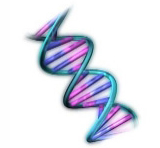DNA on a Rainy Day
 I while ago I stumbled on a science site that expanded on a simple procedure to extract DNA from living matter (or from anything that once was alive and hasn't decayed too much). Yesterday I decided to put it to the test. You can find a complete layman's version here, including some enlightening schematics. It's applied to peas.
I while ago I stumbled on a science site that expanded on a simple procedure to extract DNA from living matter (or from anything that once was alive and hasn't decayed too much). Yesterday I decided to put it to the test. You can find a complete layman's version here, including some enlightening schematics. It's applied to peas.Briefly put, the protocol constitutes four separate steps:
- Making lightly salted "pea cell soup".
- Breaking down the cells and nucleus membranes, thereby releasing the raw DNA into the mix, by adding washing-up liquid.
- Breaking down the proteins onto which the DNA is coiled, by adding an enzyme to the mix.
- Separating the freed DNA by means of alcohol.
I had to make a few small changes to the recipe though:
- Having no split peas at hand I used frozen ones and substituted the recommended 100 ml of the former by 100 g of the latter (a bit of a mistake).
- Having no "meat tenderizer" at hand (it seems they don't sell that stuff in Europe, at least not in retail), I followed the suggestion of trying pineapple juice, which contains the enzyme Bromelain, also found in meat tenderizers. I made freshly squeezed pineapple juice by straining some 10 ml of finely chopped pineapple through a tea-strainer.
- Having no rubbing alcohol, I replaced it with (purple) methylated spirits, which is essentially methanol.
Not having the slightest idea how much Bromelain my juice contained, I decided to run a few tests at once. And so after completing steps 1 and 2, I added respectively 1 ml, 2 ml and 3 ml of pineapple juice to three test-tubes (from my daughter's chemset, every home should have one!), each containing the same amount of treated pea soup (about 3 ml).
After that I carefully added the methylated spirits (which I had previously cooled in the freezer, as recommended in this slightly more advanced procedure), about 3 ml to each of the three tubes.
Very little patience was rewarded almost immediately, as a white, flocular material started to appear in the zone separating the pea soup and the alcohol! It's slightly eerie to see the stuff that is so vital to life appear before your very own eyes...
A few conclusions could also be drawn:
- The total amount of DNA (plus some RNA, as this is so-called 'genomic DNA') seemed a lot smaller "than in the picture". This I believe is partly due to my ill-advised substitution of the recommended 100 ml of split peas, by 100 g of frozen peas: split peas are a lot more dense than frozen or fresh peas, so a 100 ml of splits probably weighs up to 150 to 200 g. My concoction simply didn't contain as much DNA as planned...
- As it rose through the methanol, the DNA showed its stringy nature but it wasn't quire as stringy as I expected: too much stirring (these macromolecules are fragile) or too high expectations?
- The amount of DNA was clearly proportional to the amount of pineapple juice used. At first glance it would be tempting to attribute this to the greater quantity of enzyme present but that doesn't necessarily make sense. The pineapple juice was a thick and non transparent liquid, probably closer to "pineapple cell soup" than an actual Bromelain solution and thus more DNA will have been present in the test-tubes containing the higher amounts of pineapple juice. An additional test using 3 ml of pineapple juice with a reduced amount (about 2 ml) of pea cell soup yielded about the same amount of DNA as the 3/3 combination, indicating I was also extracting pineapple DNA and not just pea DNA. One way to find out would be to filter the pineapple juice...
In a next session I'll be testing some of these conclusions/hypotheses by means of a small factorial experimental design using split v. frozen, filtered v. unfiltered pineapple juice and 1 ml v. 3 ml of pineapple juice as factors. Using a saturated randomised experiment matrix, I can evaluate the effects of these three factors by means of just four runs (and as luck would have it, I have exactly four test-tubes!)
The procedure can be applied to just about any living matter and I'll be testing it on one of my closest enemies soon enough (just kiddin', just kiddin'!) but peas are a good source because they are seeds and contain lots of the stringy stuff. And most of Gregor Mendel's groundbreaking work on the laws of genetic inheritance was also done on peas and pea plants. So, let's hear it for the father of modern genetics and his trusted friend, the good old pea! But if you can't be bothered with DNA or genetics, here's some recipes for tasty pea soup...
Update: the results of the additional tests can be found here.


0 Comments:
Post a Comment
<< Home